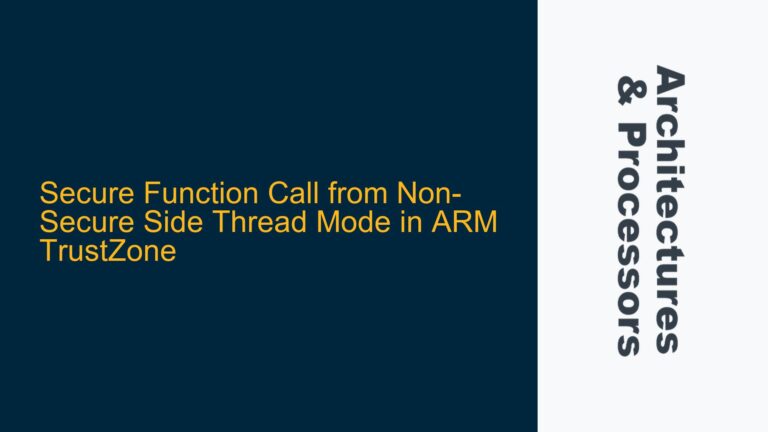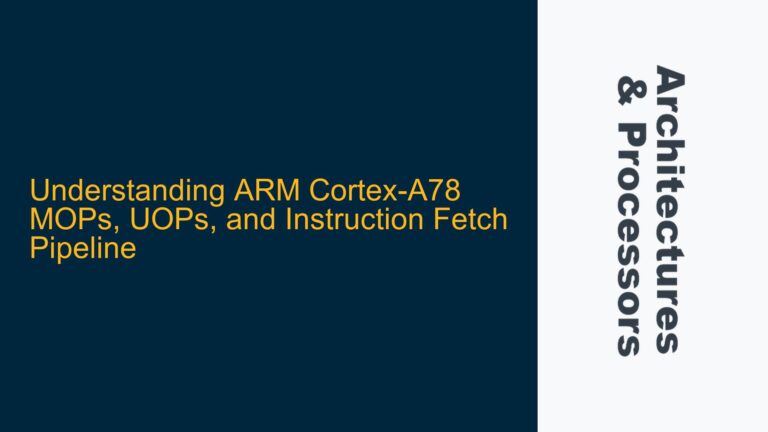ARM Cortex-M0/3/4 Toolchain Generating Mixed Thumb-16 and Thumb-32 Instructions
The ARM Cortex-M series of processors, including the Cortex-M0, Cortex-M3, and Cortex-M4, are designed to execute Thumb instructions, which are a compact form of ARM instructions. Thumb instructions come in two variants: Thumb-16 and Thumb-32. Thumb-16 instructions are 16 bits wide, offering higher code density, while Thumb-32 instructions are 32 bits wide, providing additional functionality and performance benefits. However, in certain scenarios, developers may want to restrict the toolchain to generate only Thumb-16 instructions. This could be due to specific memory constraints, compatibility requirements, or performance optimization goals.
The issue arises when the toolchain, such as GCC, generates a mix of Thumb-16 and Thumb-32 instructions, even when the target is an ARM Cortex-M processor. This mixed instruction set can lead to inefficiencies in code size and potentially unexpected behavior in tightly constrained embedded systems. The challenge is to configure the toolchain to exclusively generate Thumb-16 instructions, ensuring that no Thumb-32 instructions are included in the final binary.
Toolchain Configuration Limitations and Instruction Set Dependencies
One of the primary reasons why the toolchain might generate Thumb-32 instructions, even when targeting ARM Cortex-M processors, is the inherent limitations of the Thumb-16 instruction set. Thumb-16 instructions are designed for simplicity and code density, but they lack certain capabilities that are available in Thumb-32 instructions. For example, Thumb-16 instructions have limited addressing modes, fewer registers available for certain operations, and reduced flexibility in immediate value encoding. As a result, the compiler may automatically generate Thumb-32 instructions when it encounters operations that cannot be efficiently encoded using Thumb-16 instructions.
Another factor contributing to the generation of Thumb-32 instructions is the toolchain’s optimization settings. Compilers like GCC often prioritize performance and code size optimization, which can lead to the inclusion of Thumb-32 instructions even when Thumb-16 instructions might suffice. Additionally, certain compiler flags or target-specific configurations might inadvertently enable the generation of Thumb-32 instructions, especially if the toolchain is not explicitly instructed to restrict itself to Thumb-16.
Furthermore, the ARM architecture itself imposes some constraints. For instance, the Cortex-M4 processor, which includes a DSP extension and optional floating-point unit (FPU), may require Thumb-32 instructions to fully utilize these features. In such cases, the toolchain might generate Thumb-32 instructions to ensure that the hardware capabilities are properly leveraged, even if the developer intends to use only Thumb-16 instructions.
Configuring GCC to Enforce Thumb-16 Instruction Set Usage
To address the issue of mixed Thumb-16 and Thumb-32 instruction generation, developers can take several steps to configure the toolchain to enforce the use of Thumb-16 instructions exclusively. The following troubleshooting steps and solutions outline the process for achieving this goal using the GCC toolchain.
Step 1: Understanding GCC Target-Specific Options
The first step in enforcing Thumb-16 instruction usage is to understand the target-specific options available in the GCC toolchain. GCC provides a range of options that allow developers to control the instruction set and optimization behavior for ARM targets. One of the key options is -mthumb, which instructs the compiler to generate Thumb instructions. However, this option alone does not restrict the compiler to Thumb-16 instructions; it allows the generation of both Thumb-16 and Thumb-32 instructions.
To explore the available options, developers can use the --target-help flag with the GCC compiler. This flag provides a detailed list of target-specific options, including those related to the ARM architecture. For example, running the command arm-none-eabi-gcc --target-help will display a list of options that can be used to configure the compiler for ARM targets. Among these options, developers should look for flags that control the instruction set and optimization behavior.
Step 2: Restricting Instruction Set to Thumb-16
Once the target-specific options are understood, the next step is to configure the compiler to restrict the instruction set to Thumb-16. Unfortunately, GCC does not provide a direct option to enforce Thumb-16 instruction usage exclusively. However, developers can achieve this goal by combining several compiler flags and optimization settings.
One approach is to use the -mthumb flag in combination with the -march=armv6-m or -march=armv7-m flag, depending on the specific Cortex-M processor being targeted. The -march flag specifies the target architecture, and by selecting an architecture that does not support Thumb-32 instructions, developers can effectively restrict the compiler to Thumb-16 instructions. For example, the armv6-m architecture, which is used by the Cortex-M0 processor, does not support Thumb-32 instructions. Therefore, using the -march=armv6-m flag with the -mthumb flag will ensure that only Thumb-16 instructions are generated.
However, this approach has limitations. The armv6-m architecture is quite restrictive and may not be suitable for all Cortex-M processors, especially those with more advanced features like the Cortex-M3 and Cortex-M4. In such cases, developers may need to use the -march=armv7-m flag, which supports Thumb-32 instructions. To enforce Thumb-16 instruction usage in this scenario, developers can use the -mno-thumb-interwork flag, which disables the generation of Thumb-32 instructions. Additionally, the -Os flag can be used to optimize for code size, which may encourage the compiler to prefer Thumb-16 instructions over Thumb-32 instructions.
Step 3: Verifying Instruction Set Usage
After configuring the compiler flags, it is essential to verify that the generated binary contains only Thumb-16 instructions. This can be done by disassembling the binary and inspecting the generated instructions. Tools like objdump or arm-none-eabi-objdump can be used to disassemble the binary and display the instruction set.
For example, the following command can be used to disassemble a binary file named output.elf:
arm-none-eabi-objdump -d output.elf
The output of this command will display the disassembled instructions, allowing developers to inspect whether any Thumb-32 instructions are present. If Thumb-32 instructions are still being generated, developers may need to revisit the compiler flags and adjust the optimization settings or target architecture to further restrict the instruction set.
Step 4: Handling Edge Cases and Limitations
In some cases, it may not be possible to completely eliminate Thumb-32 instructions due to the limitations of the Thumb-16 instruction set. For example, certain operations, such as long jumps or complex addressing modes, may require Thumb-32 instructions. In such scenarios, developers may need to accept the presence of a small number of Thumb-32 instructions or consider alternative approaches, such as rewriting critical sections of code to use only Thumb-16 instructions.
Additionally, developers should be aware that enforcing Thumb-16 instruction usage may impact performance and functionality, especially on processors like the Cortex-M4 that are designed to take advantage of Thumb-32 instructions. Therefore, it is important to carefully evaluate the trade-offs between code size, performance, and functionality when enforcing Thumb-16 instruction usage.
Step 5: Exploring Alternative Toolchains and Compiler Options
If the GCC toolchain does not provide sufficient control over the instruction set, developers may consider exploring alternative toolchains or compiler options. For example, the ARM Compiler (armclang) provides more fine-grained control over the instruction set and optimization behavior. ARM Compiler offers options like --thumb and --restrict_thumb that allow developers to enforce Thumb-16 instruction usage more effectively.
Additionally, developers can consider using assembly language for critical sections of code where Thumb-16 instruction usage is essential. By writing these sections in assembly, developers can have full control over the instruction set and ensure that only Thumb-16 instructions are used.
Step 6: Best Practices for Thumb-16 Instruction Usage
To ensure reliable and efficient Thumb-16 instruction usage, developers should follow best practices when configuring the toolchain and writing code. These best practices include:
-
Use the Correct Target Architecture: Select the appropriate target architecture (
-march) that aligns with the desired instruction set. For example, use-march=armv6-mfor Cortex-M0 processors to enforce Thumb-16 instruction usage. -
Optimize for Code Size: Use the
-Osflag to optimize for code size, which may encourage the compiler to prefer Thumb-16 instructions over Thumb-32 instructions. -
Disable Thumb-32 Instructions: Use the
-mno-thumb-interworkflag to disable the generation of Thumb-32 instructions, especially when targeting Cortex-M3 and Cortex-M4 processors. -
Verify Instruction Set Usage: Regularly disassemble the generated binary to verify that only Thumb-16 instructions are being used. This helps identify any unintended Thumb-32 instructions and allows for timely adjustments to the compiler flags.
-
Consider Alternative Toolchains: If GCC does not provide sufficient control over the instruction set, consider using alternative toolchains like ARM Compiler, which offer more fine-grained control over the instruction set and optimization behavior.
-
Use Assembly for Critical Sections: For critical sections of code where Thumb-16 instruction usage is essential, consider writing these sections in assembly language to ensure full control over the instruction set.
By following these best practices, developers can effectively enforce Thumb-16 instruction usage in their ARM Cortex-M projects, ensuring optimal code density and performance in constrained embedded systems.
Conclusion
Enforcing Thumb-16 instruction usage in ARM Cortex-M0/3/4 toolchains requires a deep understanding of the toolchain’s configuration options and the limitations of the Thumb-16 instruction set. By carefully selecting the appropriate compiler flags, optimizing for code size, and verifying the generated instruction set, developers can achieve their goal of using only Thumb-16 instructions. However, it is important to recognize the trade-offs involved and consider alternative approaches when necessary. With the right configuration and best practices, developers can ensure reliable and efficient Thumb-16 instruction usage in their embedded systems.






